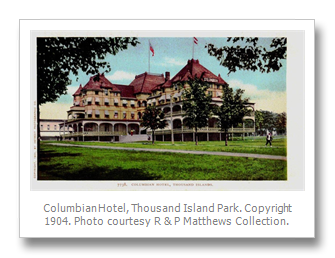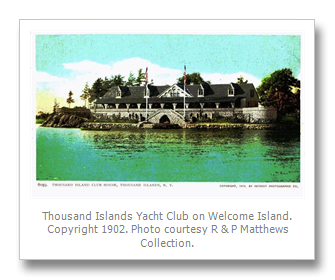Written by
Robert L. Matthews posted on March 13, 2012 07:21
Note: All the postcards included with this article were published by the Detroit Photographic Co. and thus date before 1905. CLICK to enlarge each photograph
If you collect Thousand Islands memorabilia, my guess is that your first purchase might have been a postcard. That was my beginning and at the time my goal was to acquire as many different pictures as possible provided the scenes were of the Thousand Islands. Later, when I realized that all postcards were not the same, collecting postcards took on a whole new approach.
The great popularity of postcards has long since passed. Compare today to one hundred years ago when in 1908, the U.S. Post Office reported that 650 million postcards were being mailed annually and the number of mailings was doubling every year. Remember a great many postcards were purchased but never mailed. They were taken home and saved as a remembrance of a wonderful trip or to show your friends where you vacationed. Those years, before World War One, were the golden era of postcards.
From 1898 to 1901 the government did not allow publishers to use the word “Postcard” to describe their product. The correct term was “Private Mailing Card” or “PMC” for short. Rather than adding confusion to this article, all cards, including private mailing cards, will be referred to as postcards. If you have a “Private Mailing Card” you can date it to the years 1898 to 1901.
World War One ended the golden era of postcards as most of the quality postcards came from Germany. Their printing technology was more advanced than other countries with maybe one exception. That exception was the Detroit Photographic Co. color postcards. Detroit Photographic Co. began operations in the late 1890’s when they acquired a Swiss printing process called photochrom. This technique enhanced black and white photography to a color image well before color photography was established. As you can see from the examples, the color was not always perfect but the postcards had great appeal. They offered an alternative to the black and white postcards so common at the time. Some early German postcards were also colored but were hand tinted. Those postcards, published by Rotograph, are also great collectables.


Detroit Photographic Co. changed its name at the end 1904 to Detroit Publishing Co. but for all practical purposes it was the same company. The name change is a great way to date their postcards. Those reading Detroit Photographic Co. establishes a date of 1904 or earlier and Detroit Publishing Co. means the postcard dates 1905 or later. Many of the cards carry a copyright date which eliminates the guesswork. The business lasted until 1924 when the company filed for bankruptcy.
You might be surprised that there are over 25,000 Detroit Photographic/Publishers images on file at the Library of Congress. While this is a staggering number, my guess is that many pictures have been lost or destroyed as some postcard images cannot be found in their inventory. Those dealing with the Thousand Islands number about one hundred 8”X10” black and white glass negatives and can be viewed on the Library of Congress web site.
William Henry Jackson was probably their most prolific and famous photographer and is credited with taking many of the Thousand Island photographs. Jackson joined the Detroit Photogaphic Co. in 1897 when he sold the company his extensive inventory of pictures. While on assignment in the Thousand Islands, he must have had a fascination with Round Island as many of his photographs in the Library of Congress are either Frontenac Hotel related or scenes on Round Island. My guess is that he might have stayed at the Frontenac while on the job at the time.
You should be aware that there is a book of early color photographs of America and the source of these color photographs is [you guessed it] the Detroit Photographic/Publishing Companies. The title of the book is The Birth of a Century.
By Robert L. Matthews, Fishers Landing
This the fourth article by Robert L. Matthews giving us a sample of Thousand Islands memorabilia. The first, TI Collectables, Part I Squiggle Glass, appeared in the November 2011 issue , in December we presented TI Collectables Part II, Four Track Series Brochures and in January he wrote T I Collectables, Part III, Wheelock Souvenir China.
Robert is the author of two popular books: Glimpses of St. Lawrence Summer Life: Souvenirs from the Thousand Islands: Robert and Prudence Matthews Collection, and A History of the Thousand Islands Yacht Club, published in 2009. Bob presented five articles last winter. He and his wife Prudence ( well known River artist whose work was presented in Hooked on Prudence in 2009) have one of the most extensive collections of Thousand Islands memorabilia. When not at their beautiful River cottage at Fisher’s Landing, they live in St. Petersburg, Florida.
NOTE: Do you have a favorite Thousand Islands souvenir story? If so, don’t forget to tell us about it in our comment section.